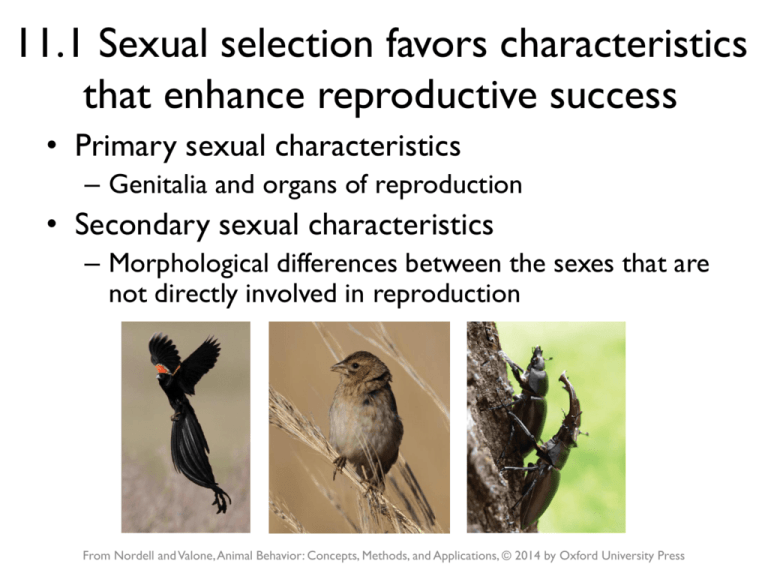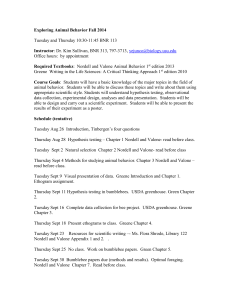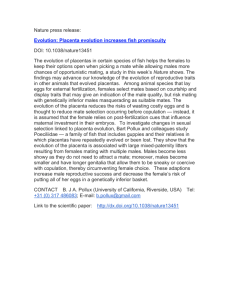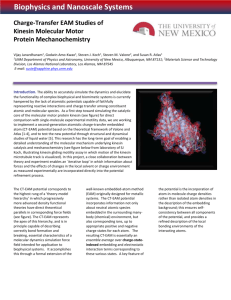Mating behavior
advertisement

11.1 Sexual selection favors characteristics that enhance reproductive success • Primary sexual characteristics – Genitalia and organs of reproduction • Secondary sexual characteristics – Morphological differences between the sexes that are not directly involved in reproduction From Nordell and Valone, Animal Behavior: Concepts, Methods, and Applications, © 2014 by Oxford University Press Bateman’s hypothesis • Bateman’s hypothesis: – Female reproductive success is most strongly limited by the number and success of eggs that she can produce, whereas male reproductive success is limited by the number of mates From Nordell and Valone, Animal Behavior: Concepts, Methods, and Applications, © 2014 by Oxford University Press Figure 11-9 Figure 11-10 Figure 11-11 Figure 11-12 Figure 10.8 Differences between the sexes in sexual behavior may arise from fundamental differences in parental investment that affect the rate at which individuals can produce offspring Featured Research Antlers as weapons in red deer • Research question: Are antlers weapons used in mate competition? (Kruuk et al. 2002) From Nordell and Valone, Animal Behavior: Concepts, Methods, and Applications, © 2014 by Oxford University Press Featured Research Antlers as weapons in red deer • Methods: – Red deer (Cervus elaphas) – Collected and weighed antlers shed – Used blood samples to determine reproductive success (paternity) From Nordell and Valone, Animal Behavior: Concepts, Methods, and Applications, © 2014 by Oxford University Press Featured Research Antlers as weapons in red deer • Results: – Males with larger antlers had higher reproductive success • Conclusion: – Sexual selection has influenced antlers as an exaggerated trait in mate choice From Nordell and Valone, Animal Behavior: Concepts, Methods, and Applications, © 2014 by Oxford University Press Featured Research Weapon size and mating success in dung beetles • Research question: What is the role of the male’s horn-like projection? (Pomfret & Knell 2006) • Hypothesis: Large horns provide an advantage in mate competition • Prediction: Males with the larger horn will win most fights From Nordell and Valone, Animal Behavior: Concepts, Methods, and Applications, © 2014 by Oxford University Press Featured Research Weapon size and mating success in dung beetles • Methods: – Dung beetles (Euoniticellus intermedius) – Staged fights between males matched for body size but not horn length – Recorded outcome of interactions and mating success From Nordell and Valone, Animal Behavior: Concepts, Methods, and Applications, © 2014 by Oxford University Press Featured Research Weapon size and mating success in dung beetles • Results: – Males with larger horns won more fights • Conclusion: – The maintenance of long horns can be explained by sexual selection driven by male-male competition From Nordell and Valone, Animal Behavior: Concepts, Methods, and Applications, © 2014 by Oxford University Press Featured Research Ornaments and mate choice in peafowl • Research question: Are peacock tails an ornament used in mate choice? (Loyau, Saint Jalme, & Sorci 2005) • Males aggregate on leks, where they display to females From Nordell and Valone, Animal Behavior: Concepts, Methods, and Applications, © 2014 by Oxford University Press Featured Research Ornaments and mate choice in peafowl • Methods: – Peacocks (Pavo cristatus) – Measured: • Tail length and male body size • Number and duration of tail displays • Number of vocalizations and copulations From Nordell and Valone, Animal Behavior: Concepts, Methods, and Applications, © 2014 by Oxford University Press Featured Research Ornaments and mate choice in peafowl • Results: – Larger males with longer tails were most successful in defending a display site From Nordell and Valone, Animal Behavior: Concepts, Methods, and Applications, © 2014 by Oxford University Press Featured Research Ornaments and mate choice in peafowl • Results: – Males performing the most displays and with the greatest number of ocelli obtained the most copulations • Conclusion: – Mate competition and mate choice are important in evolution of peacock tail From Nordell and Valone, Animal Behavior: Concepts, Methods, and Applications, © 2014 by Oxford University Press Featured Research The origin of sexually selected traits: the sensory bias hypothesis in guppies • Research question: How does a male trait become selected in female mate preference? (Rodd et al. 2002) • Hypothesis: Sensory bias hypothesis – female mating preferences are a byproduct of preexisting biases in a female’s sensory system • Prediction: Males and females should be attracted to orange-colored objects because orange is associated with carotenoids From Nordell and Valone, Animal Behavior: Concepts, Methods, and Applications, © 2014 by Oxford University Press Featured Research The origin of sexually selected traits: the sensory bias hypothesis in guppies • Methods: – Guppies (Poecilia reticulata) – Several populations – Placed small color discs on leaf in water – Recorded all approaches and pecks From Nordell and Valone, Animal Behavior: Concepts, Methods, and Applications, © 2014 by Oxford University Press Featured Research The origin of sexually selected traits: the sensory bias hypothesis in guppies • Results: – Males and females were attracted to orange and red discs • Conclusion: – Female mating preference could be linked to preexisting preference for orange food objects From Nordell and Valone, Animal Behavior: Concepts, Methods, and Applications, © 2014 by Oxford University Press Jones and Hunter 1998 From Nordell and Valone, Animal Behavior: Concepts, Methods, and Applications, © 2014 by Oxford University Press From Nordell and Valone, Animal Behavior: Concepts, Methods, and Applications, © 2014 by Oxford University Press 11.2 Females select males to obtain direct material benefits • Direct material benefits – Material resources obtained by a female from mating with a particular male • Nuptial gift – A physical resource such as a food item that a male provides to a female to enhance his mating success From Nordell and Valone, Animal Behavior: Concepts, Methods, and Applications, © 2014 by Oxford University Press Featured Research Female choice and nuptial gifts in fireflies • Research question: How does the variation in the duration of male flashes affect female choice and fitness? (Lewis, Cratsley, & Rooney 2004) From Nordell and Valone, Animal Behavior: Concepts, Methods, and Applications, © 2014 by Oxford University Press Featured Research Female choice and nuptial gifts in fireflies • Methods: – Fireflies (Photinus ignitus) – Measured male flash duration and spermatophore size – Created flashes of different lengths and measured female response From Nordell and Valone, Animal Behavior: Concepts, Methods, and Applications, © 2014 by Oxford University Press Featured Research Female choice and nuptial gifts in fireflies • Results: – Males with longer flash duration had larger spermatophores From Nordell and Valone, Animal Behavior: Concepts, Methods, and Applications, © 2014 by Oxford University Press Featured Research Female choice and nuptial gifts in fireflies • Results: – Females responded more to longer flashes • Conclusion: – Females prefer to mate with males with the longest flash duration and thus the largest spermatophores, which should increase fitness From Nordell and Valone, Animal Behavior: Concepts, Methods, and Applications, © 2014 by Oxford University Press Featured Research Female choice and territory quality in lizards • Research question: How does territory quality affect female choice and fitness? (Calsbeek & Sinervo 2002) • Territory quality is based on rockiness (microclimates) From Nordell and Valone, Animal Behavior: Concepts, Methods, and Applications, © 2014 by Oxford University Press Featured Research Female choice and territory quality in lizards • Methods: – Side-blotched lizards (Uta stansburiana) – Larger males have territories with more rocks – Manipulated territory quality • Added rocks to small males’ territories • Removed rocks from large males’ territories – Observed female mate choice – Measured egg-laying date and egg mass of females From Nordell and Valone, Animal Behavior: Concepts, Methods, and Applications, © 2014 by Oxford University Press Featured Research Female choice and territory quality in lizards • Results: – Females preferred improved territories – Females on improved territories laid eggs sooner and produced larger egg masses • Conclusion: – Females select males based on territory quality and derive a significant fitness gain by doing so From Nordell and Valone, Animal Behavior: Concepts, Methods, and Applications, © 2014 by Oxford University Press 11.3 Female mate choice can evolve via indirect benefits to offspring • Indirect genetic benefits – Genetic benefits females can obtain for their offspring by mating with males that have high genetic quality From Nordell and Valone, Animal Behavior: Concepts, Methods, and Applications, © 2014 by Oxford University Press Fisherian runaway and good genes • Runaway process – An evolutionary process in which a male trait coevolves with a female preference for it and becomes increasingly exaggerated • Handicap principle – Well-developed secondary sexual characteristics are costly to survival but reliable signals of fitness • Good genes – The alleles of high-quality individuals From Nordell and Valone, Animal Behavior: Concepts, Methods, and Applications, © 2014 by Oxford University Press Figure 11-32 Figure 16-14 Figure 16-15b Sexual dimorphism And behavior! Long-tailed widowbird (male on left) Featured Research Mate choice for good genes in frogs • Research question: How do females assess male quality? (Jacquiéry et al. 2009) • Hypothesis: Females select males for genetic benefits based on their vocalizations • Prediction: The most attractive males provide the best gene alleles (fitness) to offspring From Nordell and Valone, Animal Behavior: Concepts, Methods, and Applications, © 2014 by Oxford University Press Featured Research Mate choice for good genes in frogs • Methods: SONG video – European tree frogs (Hyla arborea) – Captured and identified males from four ponds – Observed number of matings – Collected egg masses and reared in lab – Measured tadpole growth rate and survival – Genotyped tadpoles to determine parentage From Nordell and Valone, Animal Behavior: Concepts, Methods, and Applications, © 2014 by Oxford University Press Featured Research Mate choice for good genes in frogs • Results: – Only 10 of 15 males sired offspring – Males that sired more offspring produced tadpoles with higher growth rates • Conclusion: – Females select males for genetic benefits From Nordell and Valone, Animal Behavior: Concepts, Methods, and Applications, © 2014 by Oxford University Press Featured Research Good genes and immune system function in birds • Research question: How does parasite load affect mate choice? (Zuk et al. 1990) • Hypothesis: Hamilton-Zuk hypothesis – Parasites and pathogens play an important role in sexual selection when secondary sexual traits are costly and condition-dependent • Predictions: 1. Females should prefer to mate with males that have the greatest expression of secondary sexual traits 2. High parasite loads will reduce that expression in males From Nordell and Valone, Animal Behavior: Concepts, Methods, and Applications, © 2014 by Oxford University Press Featured Research Good genes and immune system function in birds • Methods: – Red jungle fowl (Gallus gallus) – Infected half the males with intestinal nematode – Measured size and color intensity of comb – Conducted mate choice trials with infected and controls (uninfected) males From Nordell and Valone, Animal Behavior: Concepts, Methods, and Applications, © 2014 by Oxford University Press Featured Research Good genes and immune system function in birds • Results: – Parasitized males had smaller, duller combs than controls – Females preferred control males • Conclusion: – Support for Hamilton-Zuk hypothesis From Nordell and Valone, Animal Behavior: Concepts, Methods, and Applications, © 2014 by Oxford University Press Featured Research Mate choice fitness benefits in spiders • Research question: What is the importance of pheromones as signals of male quality in mate choice? (Koh et al. 2009) From Nordell and Valone, Animal Behavior: Concepts, Methods, and Applications, © 2014 by Oxford University Press Featured Research Mate choice fitness benefits in spiders • Methods: – Spitting spider (Scytodes sp.) – Mate choice experiment in Y test chamber • Phase 1: Two males at end of arms (chemical cues only) • Phase 2: Pheromones of males only at end of arms (on filter paper) – Mating experiment • Half of females mated with preferred male, half with nonpreferred male From Nordell and Valone, Animal Behavior: Concepts, Methods, and Applications, © 2014 by Oxford University Press Featured Research Mate choice fitness benefits in spiders • Results: – In Phase 2, almost all females chose the pheromone of the male they chose in Phase 1 – Females who mated with preferred males had larger egg sacs, more and heavier eggs, and a higher hatch rate From Nordell and Valone, Animal Behavior: Concepts, Methods, and Applications, © 2014 by Oxford University Press Featured Research Mate choice fitness benefits in spiders • Conclusion: – Male pheromones may function to convey information about male quality From Nordell and Valone, Animal Behavior: Concepts, Methods, and Applications, © 2014 by Oxford University Press 11.4 Sexual selection can also occur after mating • Mate guarding – When a male follows his mate to prevent her from mating with rivals – beetle video; fly video • Extra-pair young – Offspring of a pair-bonded female produced outside the pair bond by a third-party male From Nordell and Valone, Animal Behavior: Concepts, Methods, and Applications, © 2014 by Oxford University Press Featured Research Mate guarding in warblers • Research question: How effective is mate guarding? (Chuang-Dobbs, Webster, & Holmes 2001) From Nordell and Valone, Animal Behavior: Concepts, Methods, and Applications, © 2014 by Oxford University Press Featured Research Mate guarding in warblers • Methods: – Black-throated blue warblers (Dendroica caerulescens) – Observations: • Followed focal males and measured distance between them and their mates – Experiment: • Removed some males for one hour during female’s fertile period From Nordell and Valone, Animal Behavior: Concepts, Methods, and Applications, © 2014 by Oxford University Press Featured Research Mate guarding in warblers • Results: – Males who spent more time mate guarding had fewer extra-pair offspring – Experimentally removed males had more extra-pair offspring • Conclusion: – Mate guarding can be an effective strategy for increasing paternity assurance From Nordell and Valone, Animal Behavior: Concepts, Methods, and Applications, © 2014 by Oxford University Press Sexual selection after mating • Sperm competition – Competition between sperm of different males to fertilize eggs • Cryptic female choice – When female influences the fertilization success of sperm from one male over that of others • Inbreeding depression – A reduction in fitness as a result of mating with close relatives From Nordell and Valone, Animal Behavior: Concepts, Methods, and Applications, © 2014 by Oxford University Press Featured Research Sperm competition in tree swallows • Research question: How can males increase paternity assurance? (Crowe et al. 2009) • Hypothesis: Paternity assurance can be enhanced through frequent copulations • Prediction: An increase in copulation rate should result in an increase in paternity for a male From Nordell and Valone, Animal Behavior: Concepts, Methods, and Applications, © 2014 by Oxford University Press Featured Research Sperm competition in tree swallows • Methods: – Tree swallows (Tachycineta bicolor) – Uniquely marked birds and collected blood samples for genetic analysis – Observed focal pairs for three hours per day for two weeks From Nordell and Valone, Animal Behavior: Concepts, Methods, and Applications, © 2014 by Oxford University Press Featured Research Sperm competition in tree swallows • Results: – Increases in copulation rate resulted in decrease of extrapair offspring • Conclusion: – Males can reduce paternity loss from sperm competition by increasing their copulation frequency From Nordell and Valone, Animal Behavior: Concepts, Methods, and Applications, © 2014 by Oxford University Press Featured Research Inbreeding avoidance via cryptic female choice in spiders • Research question: Do females avoid inbreeding depression by cryptic female choice? (Welke & Schneider 2009) From Nordell and Valone, Animal Behavior: Concepts, Methods, and Applications, © 2014 by Oxford University Press Featured Research Inbreeding avoidance via cryptic female choice in spiders • Methods: – Orb spiders (Argiope lobata) – Experiment 1– Mating trials in which a female mated sequentially with: • 1) Two sibling males (SS) • 2) Two nonsibling males (NN) • 3) Sibling and nonsibling male (SN or NS) – Experiment 2 – Mating trials • One male of pair was made sterile From Nordell and Valone, Animal Behavior: Concepts, Methods, and Applications, © 2014 by Oxford University Press Featured Research Inbreeding avoidance via cryptic female choice in spiders • Results: – For second male: • Females stored more sperm from nonsibling than from sibling • More eggs fertilized • Conclusion: – Females display cryptic female choice in regard to matings with siblings, which should reduce inbreeding depression From Nordell and Valone, Animal Behavior: Concepts, Methods, and Applications, © 2014 by Oxford University Press 11.5 Mate choice by females favors alternative reproductive tactics in males • Alternative mating tactics – Multiple behavioral mating phenotypes in a population • Satellite male – Alternative, parasitic mating tactic in which a male remains near a bourgeois male to intercept females that are attracted to the bourgeois male • Sneaker male – Alternative, parasitic mating tactic in which a male attempts to avoid detection so that he can quickly enter a bourgeois territory to fertilize eggs being deposited in a nest From Nordell and Valone, Animal Behavior: Concepts, Methods, and Applications, © 2014 by Oxford University Press Evolution of alternative reproductive tactics • Conditional strategy – Use of a particular strategy based on an individual’s condition • Evolutionary stable strategy (ESS) – A strategy that, if adopted by individuals in a population, cannot be trumped by another strategy because it yields the highest fitness From Nordell and Valone, Animal Behavior: Concepts, Methods, and Applications, © 2014 by Oxford University Press Featured Research Conditional satellite males in tree frogs • Research question: Does male tree frog mating behavior represent a conditional reproductive strategy? (Humfeld 2008) • Hypothesis: Males will adopt reproductive strategies based on their condition • Predictions: 1. Males differ in attractiveness to females; unattractive males will be satellites 2. Satellite males should have the same call preferences as females (lower-frequency calls) From Nordell and Valone, Animal Behavior: Concepts, Methods, and Applications, © 2014 by Oxford University Press Featured Research Conditional satellite males in tree frogs • Methods: – Green tree frogs (Hyla cinerea) – Recorded calls of bourgeois and satellite males – Created synthesized calls (lowest frequencies 700 Hz and 840 Hz or 840 Hz and 1120 Hz) – Conducted choice tests for calls with females and satellite males From Nordell and Valone, Animal Behavior: Concepts, Methods, and Applications, © 2014 by Oxford University Press Featured Research Conditional satellite males in tree frogs • Results: – Bourgeois males were larger and produced lower-frequency calls than satellite males – Females and satellite males preferred lowest-frequency calls • Conclusion: – Males adopt a conditional strategy From Nordell and Valone, Animal Behavior: Concepts, Methods, and Applications, © 2014 by Oxford University Press Featured Research ESS and sunfish sneaker males • Research question: What is the reproductive success of parental and sneaker male pumpkinseed sunfish? (Rio-Cardenas & Webster 2008) From Nordell and Valone, Animal Behavior: Concepts, Methods, and Applications, © 2014 by Oxford University Press Featured Research ESS and sunfish sneaker males • Methods: – Pumpkinseed sunfish (Lepomis gibbosus) – Mapped all nest locations – Captured nesting males (parentals), females, and sneakers at nest and all developing eggs – Conducted genotype analysis From Nordell and Valone, Animal Behavior: Concepts, Methods, and Applications, © 2014 by Oxford University Press Featured Research ESS and sunfish sneaker males • Results: – Parentals larger and older than sneakers – Parentals sired about 85% of offspring in their nest – Sneakers are very rare in population, and their reproductive success is proportional to their abundance • Conclusion: – The two strategies have equal fitness From Nordell and Valone, Animal Behavior: Concepts, Methods, and Applications, © 2014 by Oxford University Press Two examples of alternative mating tactics. Bryan D. Neff, and Erik I. Svensson Phil. Trans. R. Soc. B 2013;368:20120045 ©2013 by The Royal Society Roughgarden 2004 Roughgarden 2004 11.6 Learning and mating • Mate choice copying – When one individual observes and copies the mating decisions of another individual • Sexual imprinting – – mate choice influenced by traits seen in ‘sensitive’ period (e.g., influenced by parents’ traits) From Nordell and Valone, Animal Behavior: Concepts, Methods, and Applications, © 2014 by Oxford University Press Featured Research Mate copying in guppies • Research question: Do females copy the mate choice of other females? (Dugatkin 1992) From Nordell and Valone, Animal Behavior: Concepts, Methods, and Applications, © 2014 by Oxford University Press Featured Research Mate copying in guppies • Methods: – Focal female mate choice test – Model female then placed next to nonchosen male so that focal female could observe – Focal female mate choice test From Nordell and Valone, Animal Behavior: Concepts, Methods, and Applications, © 2014 by Oxford University Press Featured Research Mate copying in guppies • Results: – 17 out of 20 females spent more time near the male that had been near the model female • Conclusion: – Females switched their mate choice preference to copy the mate choice of the model female From Nordell and Valone, Animal Behavior: Concepts, Methods, and Applications, © 2014 by Oxford University Press From Nordell and Valone, Animal Behavior: Concepts, Methods, and Applications, © 2014 by Oxford University Press From Nordell and Valone, Animal Behavior: Concepts, Methods, and Applications, © 2014 by Oxford University Press The benefit of mate copying • Mate choice copying should only occur when discrimination among potential mates is difficult – Males are very similar – Females are inexperienced From Nordell and Valone, Animal Behavior: Concepts, Methods, and Applications, © 2014 by Oxford University Press Featured Research Nonindependent mate choice by male mosquitofish • Research question: Does the risk of sperm competition affect mate choice? (Wong & McCarthy 2009) From Nordell and Valone, Animal Behavior: Concepts, Methods, and Applications, © 2014 by Oxford University Press Featured Research Nonindependent mate choice by male mosquitofish • Methods: – Focal male mate choice test – Rival male then placed next to each female – Focal male mate choice test – Experiment 1 – focal male cannot see rival – Experiment 2 – focal male observes rival near chosen female – Experiment 3 – focal male observes rival near nonchosen female From Nordell and Valone, Animal Behavior: Concepts, Methods, and Applications, © 2014 by Oxford University Press Featured Research Nonindependent mate choice by male mosquitofish • Results: – Experiments 1 and 3 – males preferred larger female – Experiment 2 – focal male spent less time with chosen female during the last stage • Conclusion: – Male mate choice is affected by risk of sperm competition From Nordell and Valone, Animal Behavior: Concepts, Methods, and Applications, © 2014 by Oxford University Press From Nordell and Valone, Animal Behavior: Concepts, Methods, and Applications, © 2014 by Oxford University Press Megalagrion calliphya Beautiful Hawaiian Damselfly R. Rasmussen MAP Summer 2016 1 .0 0.8 0.6 0.4 0.2 0.0 Individual Type Andromorph Gynomorph Male Proportion Sexual Interaction Time Andromorph Gynomorph Male Proportion Sexual Interactions Figure 6. The proportion of sexual interactions between Megalagrion calliphya focal andromorphs, gynomorphs, and males from Upper Mountain House Road (UMHR) (Wilcoxon Each Pair test, n=9 gynomorphs, n=8 males, n=8 andromorphs, p=0.0305 between males and andromorphs, p>0.05 for all other comparisons). In addition, the proportion of the total time spent sexually interacting between the three individual types at UMHR (Wilcoxon Each Pair test, n=10 gynomorphs, n=11 males, n=10 andromorphs, p=0.0365). The quartile method was used to calculate endpoints. Outliers are signified by the * symbol.






